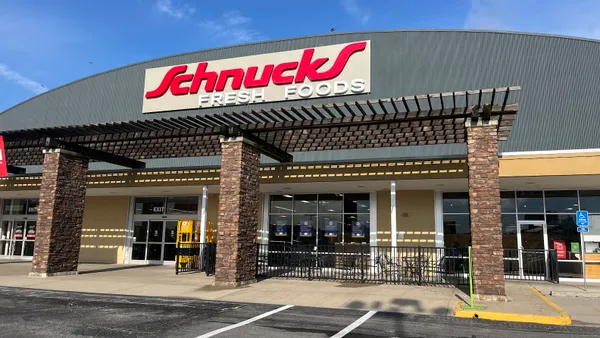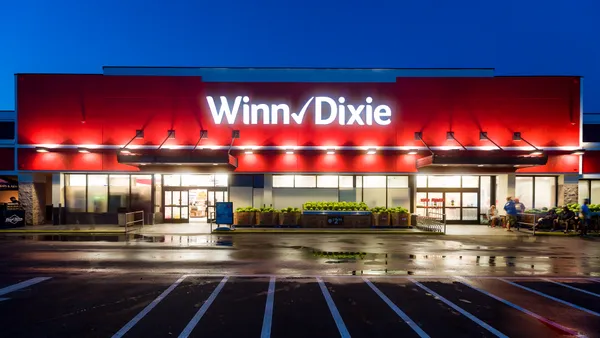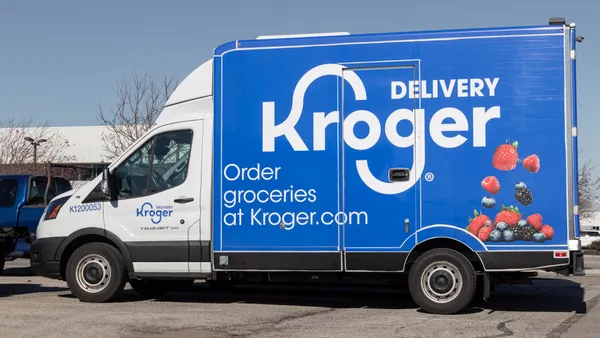Dive Brief:
- With one week left to go in its fiscal first quarter, Grocery Outlet is seeing comparable-store sales in the “mid-teens,” fueled by increasing numbers of trips and larger basket sizes spurred by the coronavirus pandemic, the company’s chief financial officer, Charles Bracher, said during an earnings call Tuesday.
- Grocery Outlet did not offer guidance for fiscal 2020 due to unpredictability surrounding the impact of the outbreak on operations and the financial market. The company maintained its goal of opening more than two dozen stores this year, but said it expects setbacks due to delays in acquiring permits and accessing construction resources due to the pandemic.
- For the fourth quarter ended December 28, 2019, Grocery Outlet reported a 5.1% increase in comparable stores sales, up from the 4.1% increase during the year-ago period. Net sales grew 12% to $655 million while adjusted EBITDA increased 5.6% to $41.5 million.
Dive Insight:
Executives said Grocery Outlet's low-price positioning and opportunistic sourcing model allow the company to operate at a high level in the current environment and beyond.
"Our business model is particularly well-suited to serve them due to our value orientation, flexibility of our business model and the benefits of a local, independent operator operating the store," CEO Eric Lindbergh said during the company's earnings call.
Still, analysts participating in Tuesday’s call questioned whether the company would be able to continue sourcing excess product in the months ahead, given high consumer demand and manufacturers’ focus on ramping up supply in core categories.
R.J. Sheedy, Grocery Outlet’s president, said the company continues to see "healthy deal flow from suppliers" and emphasized the deep, as well as diverse, relationships it has in procurement, with no supplier accounting for more than 5% of the chain’s assortment. Over the long term, he said, Grocery Outlet stands to benefit from product surpluses once demand normalizes.
“We will keep a close eye, however, on any impact that higher primary channel sales may have on surplus inventory in the future,” Sheedy said. “Supply discontinuity is a positive for our business in the long run, and this environment represents a high degree of supply chain disruption.”
Lindbergh said the company is also being contacted by non-traditional suppliers in foodservice, hardlines and health and wellness whose clients have been forced to close recently.
“We’ve had some instances with health and supplement suppliers that normally sell to gyms and other fitness-based retailers reaching out to us with surplus inventory,” he said.
Like most other grocers in the U.S., the chain has seen a spike in demand across categories over the past few weeks and is laboring to shore up supplies in essential categories. The company has turned off traditional marketing campaigns and focused instead on messaging that emphasizes customer safety and product availability. Some of the chain’s independent managers have taken to social media to communicate with shoppers.
“They’re literally walking up and down the aisles on Facebook Live, and it’s very much appreciated by customers,” Sheedy said.
The chain’s independent operator community has introduced measures around crowd control and store hygiene, as well as signage indicating product limits and availability. Several operators are also trialing curbside pickup — a first for Grocery Outlet — and Sheedy said the company may roll that out more broadly in the weeks ahead as shoppers look for ways to get products without stepping foot inside stores.
“We want to help get food to folks in any way possible,” he said, noting the company is still focused on store trips and does not anticipate a long-term investment in e-commerce.
Although Grocery Outlet did not set guidance for fiscal 2020, executives said the company still expects comp-store growth between 1% and 3% in the years ahead, with store count increasing by around 10% annually. If the U.S. economy enters a recession, as many experts expect, Grocery Outlet stands to capitalize.
“If this leads to recession we think this’ll be a pretty unique situation,” Lindbergh said. “There’s no crystal ball, but we do think people will reset to value.”









